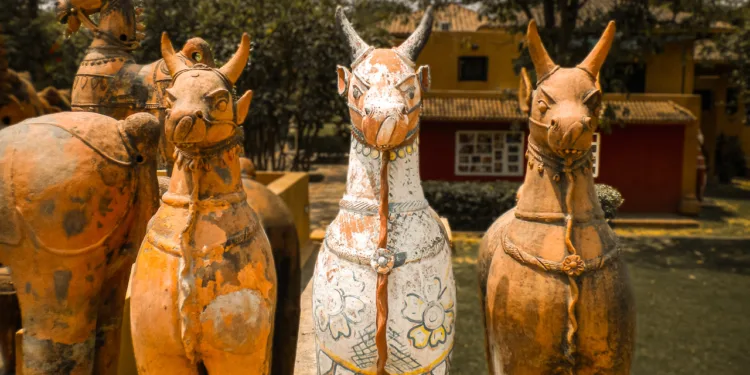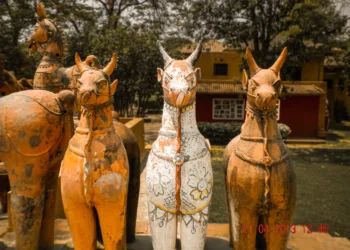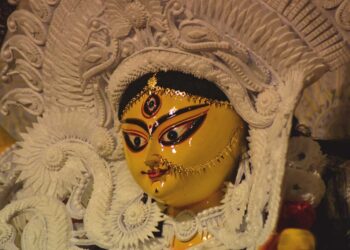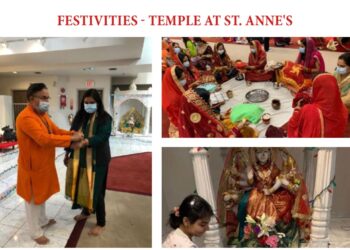In India, specific materials and processes have intricate links with rites—clay fashioned into an idol acquires divinity until the celestial spirit departs and the clay is immersed to return whence it came
BY SNEH HAZRA
Rituals play a major role in everyday life in India, especially for Hindus. There is a range of customs and observances such as fasting during festivals, rites of passage in marriages, births, deaths, and rituals associated with the waxing and waning of the moon. As laborious and shorn of value as they may seem to the agnostic, these rituals help us stay in touch with our heritage, forge a sense of belonging and community, and are something to look forward to, especially when we are away from our homeland and living in a different culture.
In all these rituals, objects—sacred and auspicious—food, music, gestures, words and aromas constitute an essential part. The materials and processes associated with ritual paraphernalia have metaphoric meanings in addition to the apparent reason for use, i.e. practicality and indigenous availability.
The choice of materials and process for a ceremonial object sometimes becomes the vehicle for communicating the intent of the ritual and information about communities who make these objects. These metaphoric meanings of materials and their associated values of sacredness and purity often emanate from local folklore.
Take, for example, the “dhaker saaj” or the sholapith (Aeschynomene aspera) decorations used to embellish the backdrop of the deities during Durga Puja celebrations. The practical reason for its usage is that it is a readily available, extremely soft and willowy weed with ivory-white pulp that is easily fashioned into intricate, layered designs. What deems it fit for use in sacred spaces is that it is associated with values of untouched purity as it is pristine white despite growing in waterlogged, marshy areas. And, according to east Indian folklore, its origin is linked with Shiva. The story goes that Shiva wanted to wear white ornaments for his wedding and requested Vishwakarma, the god of artisans, to make them. But Vishwakarma was clueless. So Shiva plucked a strand of hair from his head and threw it into a pond. From it grew the sholapith reed. Shiva’s wedding ornaments were crafted by a man called Malakar (meaning necklace maker). Hence, artisans working with sholapith bear Malakar as their last name. The association of sholapith with Shiva accords it greater relevance in the Durga Puja celebrations. Durga is Shiva’s consort, and they constitute two inseparable parts of a whole.

Some of these associations around the sanctity and purity of materials may be counterintuitive. The astadhatu alloy mentioned in the Shilpshastra, used to cast idols, proffers an interesting example. Associating the perceived values of auspiciousness and sanctity of material with compositional purity may not always hold. Bronze and sometimes silver and gold are preferred metals for casting idols, as indicated by ample documented evidence and treatises on arts such as the Shilpshastra. Bronze is a two-metal alloy of copper and tin. This alloy, with six more metals—gold, silver, iron, lead, zinc, and mercury—forms the astadhatu (eight-metal alloy). Though chemically and compositionally less pure or with more inclusions than bronze, astadhatu is perceived to be more auspicious (sattvic) like precious metals and is usually reserved for the more venerated gods like Vishnu, Durga, Lakshmi and Kubera.
One may well ask what values and associations are linked with the humble clay from fields and riverbanks that make it fit for creating the idols we perform our rituals around. Husk and unbaked clay are used to make temporary idols of Durga, Gauri, Mallama and Ganesh for the festivals of Durga Puja, Gauri Vrata and Ganesh Chaturthi. These idols are seen as temporary seats of these divine beings for the few days of the festivities.
In Indian belief systems, the earth or clay (maati or mitti) itself possesses a quality of sanctity. The earth (clay) is invoked in Indian scriptures like the Vedas, Bhumi Sukhtam, and Puranas, and in the songs and festive celebrations of adivasis. The clay or maati is also associated with flesh or man. In Gujarat, if a child is born without a limb, it is said that God lacked that much clay. Also, it is a common saying in India that we come from the earth and to the earth we shall return, thus associating the clay with the ability to carry, to hold a spirit. That is why, through rituals, God is invited to imbue a presence in these clay idols; the idols come alive to become a deity celebrated through the days of the festivities and then bid farewell to at the end of the celebrations. Thereafter, the ‘empty’ idol, devoid of the divine, is immersed in the river to turn into the clay it was before.
A similar belief is observed in numerous tribal communities in India, where votive figures of horses and other animals in terracotta (baked earth/clay) are offered to gods. It is believed that earthen forms of animals can substitute for real animals and are made alive by rituals, music and offerings.
Observing and attempting to understand this hierarchy of ‘purity’ and ‘sacredness’ in objects enables us to realise that the choice of materials for ritualistic paraphernalia goes beyond visually appealing combinations and carries larger meaning and associations than meet the eye. Objects used in sacred rituals hold vast information on our culture. Learning to comprehend it is essential to preserve this valuable heritage as these material associations and values influence our contemporary choices of goods and services.

(The writer is a glass and ceramic designer-maker with a keen interest in heritage crafts and related cultural practices.)








